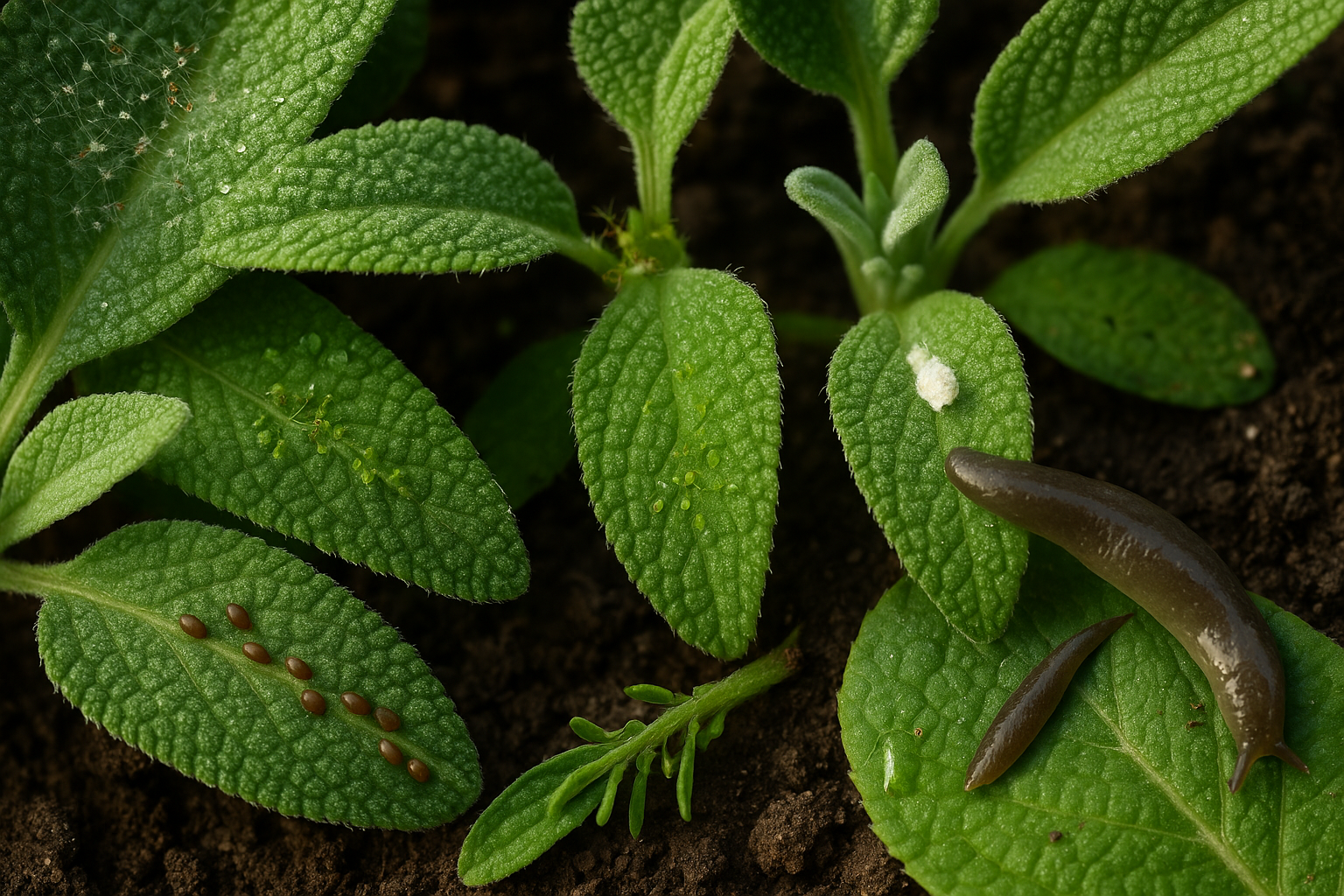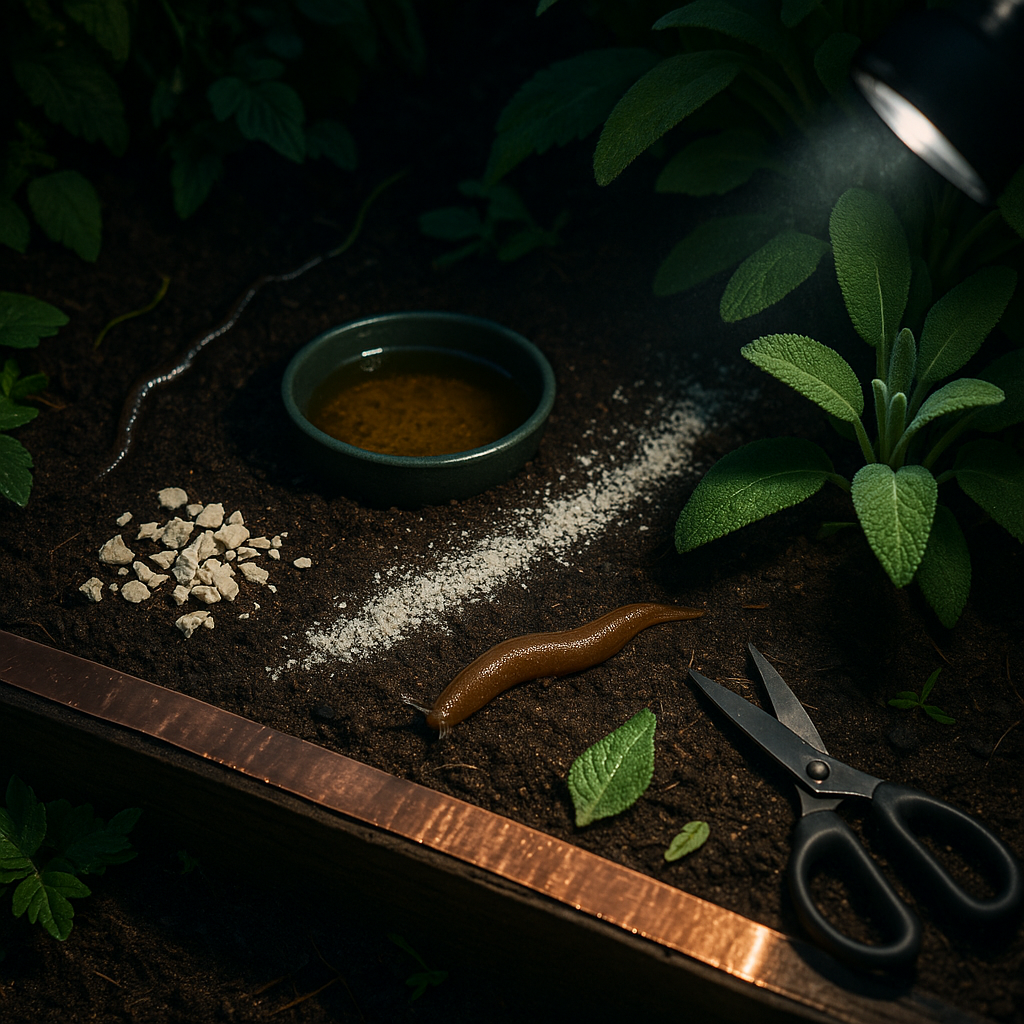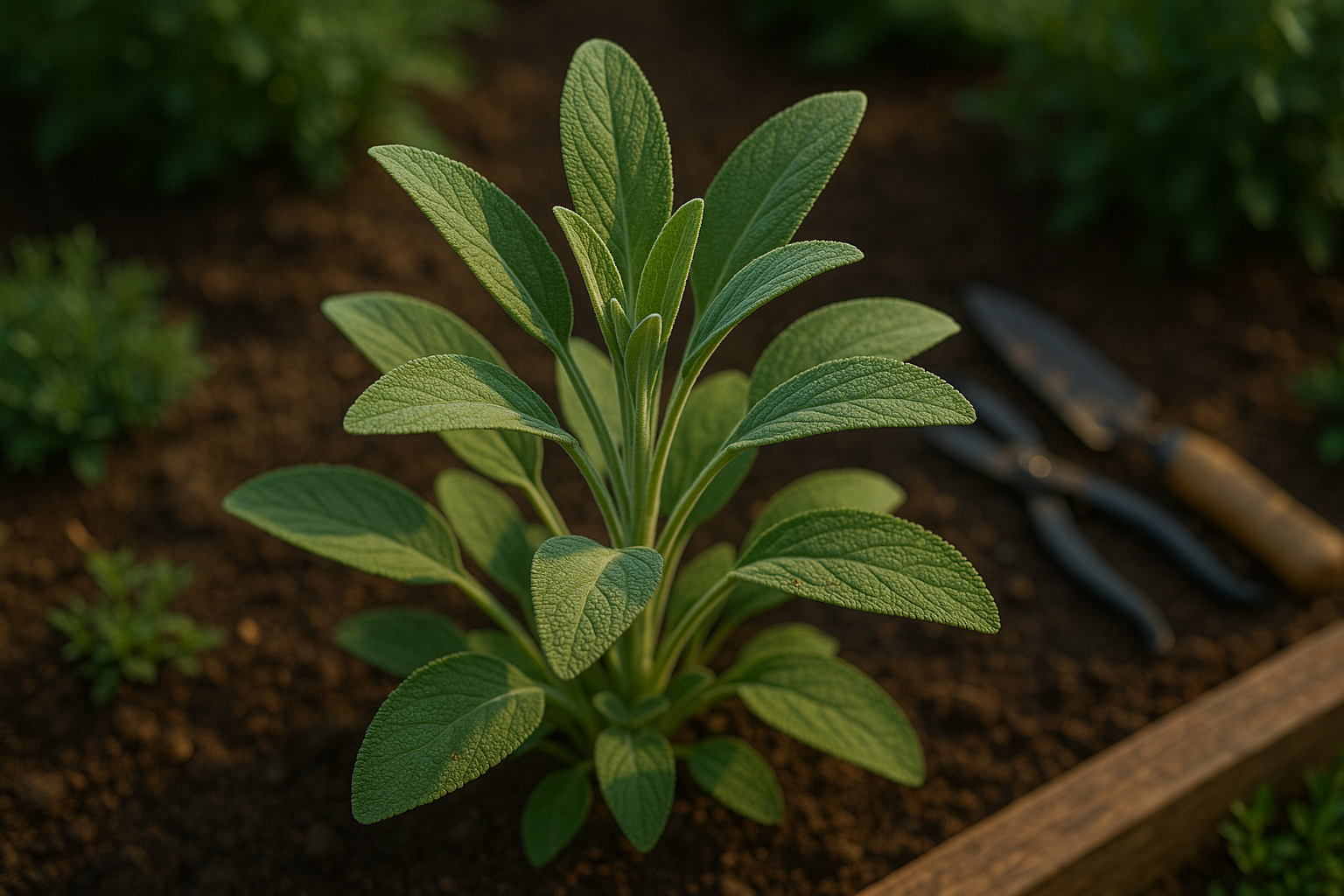Common Sage Pests and How to Identify Them

Keeping your sage plants healthy starts with knowing which pests to watch for and how to spot them early. Here’s a rundown of common culprits and their telltale signs:
- Spider Mites: Look for fine webbing on the undersides of leaves, tiny pale specks on the foliage, and general yellowing of the leaves.
- Aphids: These often cluster on new growth or stems, leaving behind sticky “honeydew” residue and causing leaves to curl or yellow.
- Mealybugs: They create cottony, white clumps in leaf joints and also produce honeydew, which can lead to black sooty mold.
- Scale Insects: Appear as small, rounded or oval brown bumps on stems or leaves and can cause yellowing and premature leaf drop.
- Slugs and Snails: Chew irregular holes in leaves and leave shiny, silvery slime trails, especially after rain or watering.
- Fungus Gnats: Tiny, mosquito-like flies flying around the soil often signal overly damp conditions. Look for weakened, stunted plants and sometimes fine root damage.
- Fruit Flies: Less common but may appear if decaying plant matter is nearby. You’ll notice small, fast-moving flies hovering around the leaves and soil.
Identifying these pests early, when their populations are still small, makes a huge difference. Early detection means you can often remove them naturally—for example, spraying plants with water to dislodge aphids and mites, picking off slugs and snails by hand, or using sticky traps for gnats and flies.
Check your sage regularly, especially the undersides of leaves and the base of the plant. A quick visual scan every few days helps you catch issues before they escalate, keeping your sage patch thriving and chemical-free.
Spider Mites, Aphids & Mealybugs
Spider mites, aphids, and mealybugs are some of the most troublesome sap-sucking pests in gardens and on houseplants. They cause yellowing leaves, drooping stems, curling edges, and stunted growth by draining the plant’s vital fluids. You might notice fine webbing clinging to leaves—especially with spider mite infestations—or sticky residue (honeydew) and clusters of cottony masses that signal aphids or mealybugs at work.
If you see these signs, start by pruning heavily infested stems and gently wiping leaves with a damp cloth to remove visible pests. A strong jet of water from a spray bottle can also dislodge many insects.
For more persistent problems, try spraying plants with insecticidal soap or neem oil, making sure to coat the undersides of leaves where pests tend to hide. Apply these natural sprays in the early morning or late evening, when sunlight is less intense, to prevent leaf burn and allow thorough drying.
To avoid harming beneficial insects, focus sprays directly on affected areas and use them only as needed. Encourage helpful insects like ladybugs and lacewings by planting pollen-rich flowers or purchasing them from garden centers, as they naturally prey on sap-sucking pests.
Finally, check plants weekly for signs of new infestations, clean up plant debris, and avoid overcrowding to keep the environment less hospitable to pests. This also helps you detect any recurrence quickly. Regular monitoring and early intervention are key to keeping your plants healthy and your pest problems manageable.
Scale Insects and How to Handle Them
Scale insects are sneaky pests that often appear as tiny, rounded bumps on plant stems, leaves, or even fruit. They can be brown, tan, or white, and are sometimes mistaken for simple plant growths or dirt. One tell-tale sign of an infestation is a sticky substance called honeydew, left behind by the insects as they feed on plant sap. This sticky residue can attract ants and lead to unsightly black mold.
For edible herbs, chemical-free removal is best. Start by dabbing the insects with a cotton swab dipped in rubbing alcohol—the alcohol dissolves their protective coating, killing them without harming the plant. For heavier infestations, gently scrape the scales off with your fingernail or a soft toothbrush. Regularly inspecting your herbs lets you spot issues early and prevents a serious outbreak.
Horticultural oil, such as neem oil, is another safe solution. Spray your plants thoroughly to smother the pests, making sure to coat the undersides of leaves and stems. Non-toxic methods are especially important for edible plants, since harsh chemicals can linger on leaves or change the flavor of your harvest.
With regular care and these natural techniques, you can keep your herbs healthy, pest-free, and safe to eat.
Dealing With Slugs, Snails, and Other Creepers

Slugs, snails, and earwigs are common garden pests that can wreak havoc on your plants, often leaving behind clear signs like ragged holes in leaves and flowers or a shiny, silvery slime trail tracing their path. Earwigs especially love hiding in dark, moist environments and will chew not only leaves but also flower petals and soft fruits.
To keep these creepers at bay, focus on natural, chemical-free prevention methods. Nighttime handpicking is surprisingly effective—simply venture out with a flashlight after dusk and remove the pests you find. Beer traps, made by burying shallow containers filled with beer at soil level, lure slugs and snails to a boozy end. Lining your garden beds with copper tape can repel these slimy invaders, as they dislike the mild electric charge it emits on contact. Sprinkling diatomaceous earth around vulnerable plants acts like tiny shards of glass, deterring soft-bodied pests without harming your plants or pets.
Don’t forget simple maintenance tricks, too—clear away fallen leaves and old mulch, as these create perfect hiding spots. For ongoing protection and to prevent reinfestation, keep your garden tidy, water in the morning to reduce evening dampness, and create barriers with sharp sand or crushed eggshells. Rotate your prevention strategies every so often so pests don’t adapt, and always check new plants for hitchhikers before bringing them into your beds.
By blending vigilance with these natural tactics, you can enjoy a healthier garden free from the munching mouths of unwanted visitors.
Preventing Fungus Gnats and Fruit Flies
Fungus gnats and fruit flies are tiny but persistent pests that can cause serious problems for your sage plants, both indoors and outdoors. Fungus gnats lay eggs in moist soil, and when the larvae hatch, they feed on roots and organic matter, leading to root damage, stunted growth, and stressed plants. Fruit flies are typically attracted to decaying fruit and compost, but they can also be drawn to overly damp soil and organic debris around your plants.
The best way to break their life cycle is to let the top inch of soil dry out between waterings, as these pests thrive in moist conditions. Yellow sticky traps placed near the soil surface can catch adult gnats before they lay eggs. For a natural approach, beneficial nematodes—tiny soil-dwelling worms—can be watered into the soil to hunt down gnat larvae.
If you notice a severe infestation, consider gently removing your sage from its pot, shaking off the old soil, and repotting with fresh, sterile mix. Outdoors, keep garden beds free of decaying plant matter and ensure good drainage. Indoors, avoid overwatering and promptly clean up any food scraps.
With consistent care, you can keep your sage healthy and pest-free all year round.
Natural Preventive Measures for Healthy Sage
Keeping your sage plants healthy starts with regular, mindful care that focuses on preventing trouble before it begins. Make a habit of inspecting your sage every few days, checking under leaves and along stems for signs of insects or disease—early detection often means simple fixes.
Good air circulation is key: avoid overcrowding sage with other plants, and if necessary, trim back any branches to let the breeze through, as damp, stagnant air invites mildew and pests.
Don’t overlook your soil; healthy, well-drained soil is a frontline defense. Avoid overwatering, which can lead to root rot and create an open door for fungus gnats or other pests. Instead, water at the base and only when the top inch of soil is dry. Mulching with straw or shredded bark can further deter pests by acting as a physical barrier and helping the soil retain just enough moisture—not too much.
Companion Planting and Beneficial Insects
Companion planting is another natural boost: try growing sage near rosemary or thyme, both of which help repel harmful insects. You can also plant sage alongside flowers like marigolds to attract beneficial pollinators and predatory wasps.
Bringing in ladybugs or encouraging native bees with small flowering plants can keep aphids, mites, and caterpillars in check without chemicals.
Daily and Weekly Care Habits
- Make these habits part of your routine—walk your garden daily.
- Check the soil with your finger before watering.
- Top up mulch as needed.
- Weekly, take a closer look for any new issues.
- Handpick pests if you spot them.
These small, consistent steps add up and, over time, create a natural system that protects your sage and lets it thrive with minimal intervention.
